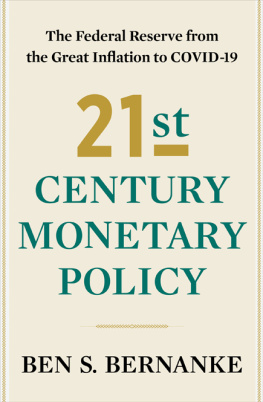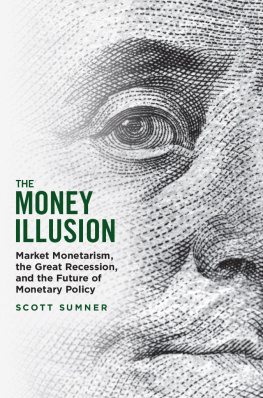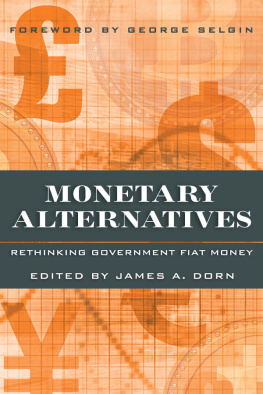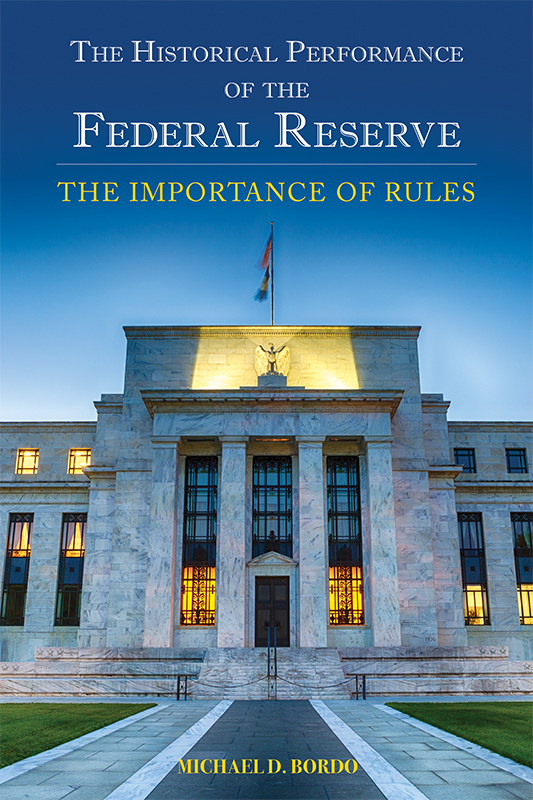Contents
Guide
T HE H ISTORICAL P ERFORMANCE OF THE
F EDERAL R ESERVE

 With its eminent scholars and world-renowned library and archives, the Hoover Institution seeks to improve the human condition by advancing ideas that promote economic opportunity and prosperity, while securing and safeguarding peace for America and all mankind. The views expressed in its publications are entirely those of the authors and do not necessarily reflect the views of the staff, officers,or Board of Overseers of the Hoover Institution.
With its eminent scholars and world-renowned library and archives, the Hoover Institution seeks to improve the human condition by advancing ideas that promote economic opportunity and prosperity, while securing and safeguarding peace for America and all mankind. The views expressed in its publications are entirely those of the authors and do not necessarily reflect the views of the staff, officers,or Board of Overseers of the Hoover Institution.
www.hoover.org
Hoover Institution Press Publication No. 695
Hoover Institution at Leland Stanford Junior University, Stanford, California 94305-6003
Copyright 2019 by the Board of Trustees of the Leland Stanford Junior University
All rights reserved. No part of this publication may be reproduced, stored in a retrieval system, or transmitted in any form or by any means, electronic, mechanical, photocopying, recording, or otherwise, without written permission of the publisher and copyright holders.
For permission to reuse material from The Historical Performance of the Federal Reserve , ISBN 978-0-8179-2214-6, please access www.copyright.com or contact the Copyright Clearance Center, Inc. (CCC), 222 Rosewood Drive, Danvers, MA 01923, 978-750-8400. CCC is a not-for-profit organization that provides licenses and registration for a variety of uses.
Efforts have been made to locate original sources, determine the current rights holders, and, if needed, obtain reproduction permissions. On verification of any such claims to rights in the articles reproduced in this book, any required corrections or clarifications will be made in subsequent printings/editions.
Hoover Institution Press assumes no responsibility for the persistence or accuracy of URLs for external or third-party Internet websites referred to in this publication, and does not guarantee that any content on such websites is, or will remain, accurate or appropriate
Cataloging-in-Publication Data is available from the Library of Congress.
ISBN-13: 978-0-8179-2214-6 (cloth)
ISBN-13: 978-0-8179-2216-0 (EPUB)
ISBN-13: 978-0-8179-2217-7 (Mobipocket)
ISBN-13: 978-0-8179-2218-4 (PDF)
Please see additional information about the original sources of many of the articles included in this volume on , which constitutes an extension of this copyright page.
CONTENTS
JOHN B. TAYLOR
MICHAEL D. BORDO
MICHAEL D. BORDO AND ANNA J. SCHWARTZ
MICHAEL D. BORDO AND ANNA J. SCHWARTZ
MICHAEL D. BORDO AND ATHANASIOS ORPHANIDES
MICHAEL D. BORDO AND JOHN S. LANDON-LANE
MICHAEL D. BORDO AND JOSEPH G. HAUBRICH
MICHAEL D. BORDO AND JOSEPH G. HAUBRICH
MICHAEL D. BORDO, CHRISTOPHER ERCEG, ANDREW LEVIN, AND RYAN MICHAELS
MICHAEL D. BORDO, MICHAEL DUEKER, AND DAVID WHEELOCK
MICHAEL D. BORDO AND JOHN LANDON-LANE
MICHAEL D. BORDO
MICHAEL D. BORDO AND JOHN LANDON-LANE
MICHAEL D. BORDO, EHSAN U. CHOUDHRI, AND ANNA J. SCHWARTZ
MICHAEL D. BORDO, EHSAN U. CHOUDHRI, AND ANNA J. SCHWARTZ
MICHAEL D. BORDO
FOREWORD
JOHN B. TAYLOR
S BOOK CONSISTS of fifteen fascinating chapters, each one a major contribution in its own right and all written by the distinguished monetary historian Michael Bordo. In many of the chapters, Michael Bordo is joined by notable coauthors, who constitute an amazing list of contributors, including Anna Schwartz, Athanasios Orphanides, John Landon-Lane, Joseph Haubrich, Chris Erceg, Andrew Levin, Ryan Michaels, Michael Dueker, David Wheelock, and Ehsan Choudhri.
As you begin to look through and read these chapters, you quickly realize that the book is much more than a collection of intriguing stand-alone pieces. The chapters are connected and woven togetheras Michael Bordo explains in a beautiful introductionto form a definitive, lessons-packed historical treatment, informed by theory and data, of the Federal Reserve and related markets and institutions.
Like Milton Friedman and Anna Schwartzs A Monetary History of the United States and Allan Meltzers A History of the Federal Reserve , Michael Bordos The Historical Performance of the Federal Reserve: The Importance of Rules covers huge expanses of history in a comprehensible way. And, as with these other historical perspectives, it develops and establishes new monetary lessons with great relevance around the world today. Whereas Friedman and Schwartz demonstrated the importance of money, and Meltzer the importance of the institutions, Bordo establishes the importance of predictable monetary strategies and specific policy rules.
As Bordo emphasizes, the important lesson from the monetary history of the United States and other advanced countries is that the pursuit of stable monetary policy guided by central banks following rule-like behavior produces low and stable inflation, stable real performance, and encourages financial stability. The case for monetary policy rules continues to be one of the most difficult policy issues facing central bank officials and societies more generally today. The evidence that Michael Bordo has uncovered in his research over the years figures importantly in this debate. Connecting the evidence from different historical episodes and periods, as accomplished in this book, further solidifies this evidence and makes it more convincing than ever.
Right from the start, in Chapter 1 on Rules versus Discretion: A Perennial Theme in Monetary Economics, Bordo concentrates on this key issue. He appropriately and fairly considers alternative views, but he concludes that the case for rules holds up very well against these alternatives. The poor performance during the great inflation of the 1970s as monetary policy deviated from rules is an important, but only one, of many pieces of evidence.
Consider, for example, his finding that both the commodity-based monetary rule implicit in the gold standard period and the fiat-based policy rule during the Great Moderation from 1985 to 2005 were associated with price stability and generally good economic performance. Both periods contrast with the poor performance and poor policy in other historical periods, including the 1970s in many countries.
Indeed, comparing and contrasting economic performance and its associated monetary policy in different historical episodes is a recurrent theme and valuable method used throughout this book. Looking at different real economic performance during different deflationary periods is another example. The book considers (1) the postCivil War greenback deflation, (2) the postWorld War I deflation, and (3) the Volcker disinflation of 19791982. Here one can see the beneficial impact of transparency and credibility in policy, which is also different in these periods. This policy difference seems to account for the widely divergent real macroeconomic effects in these three periods when the monetary policy was explicitly deflationary and brought inflation down from high levels.
Often the book usefully digs into important timing differences in central bank decisions and shows that these significantly affect economic performance. For example, the book shows that in both the 1920s and the 1950s the Federal Reserve responded relatively quickly by tightening when the aggregate price level started to rise. In the 1960s the Fed delayed its tightening, waiting until long after inflation began to rise. Thus, the Fed was often too late, and inflation picked up leading to a boom bust cycle.












 With its eminent scholars and world-renowned library and archives, the Hoover Institution seeks to improve the human condition by advancing ideas that promote economic opportunity and prosperity, while securing and safeguarding peace for America and all mankind. The views expressed in its publications are entirely those of the authors and do not necessarily reflect the views of the staff, officers,or Board of Overseers of the Hoover Institution.
With its eminent scholars and world-renowned library and archives, the Hoover Institution seeks to improve the human condition by advancing ideas that promote economic opportunity and prosperity, while securing and safeguarding peace for America and all mankind. The views expressed in its publications are entirely those of the authors and do not necessarily reflect the views of the staff, officers,or Board of Overseers of the Hoover Institution.